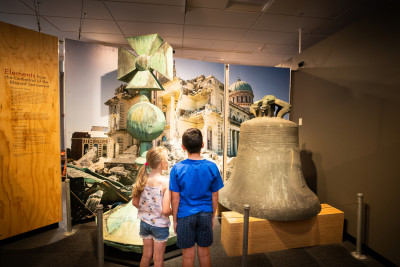Empowering the next generation for a resilient future
Living in a country prone to natural hazards puts us in a unique position to become experts in the way we understand our hazards and know how to stay safe when they strike.
Today is the International Day for Disaster Risk Reduction and this year’s theme is all about empowering the next generation for a resilient future. The good news is, there are many initiatives here in New Zealand to help young people become hazard aware and prepared.
empowering the next generation for a resilient future. The good news is, there are many initiatives here in New Zealand to help young people become hazard aware and prepared.
The Natural Hazards Commission Toka Tū Ake partners with schools and museums so tamariki and rangatahi can learn about the natural forces that shape our land. We hope to inspire students into future STEAM (science, technology, engineering, the arts, and math) careers and build awareness of hazards and their impacts from the ground up.
At Te Papa in Wellington, people can experience the Earthquake House and learn how to stay safe when their own house shakes. They can see how tsunamis are formed and create one themselves. Learning all about plate tectonics, earthquakes, volcanic eruptions and erosion is important to understanding how we can prepare for the potential impacts of our active land. There’s also an interactive Minecraft ShakerMod(external link) game available and the opportunity to see some of the 135 base isolators that Te Papa sits on to reduce shaking in a major earthquake.
The Auckland Museum hosts the Volcanoes! exhibition which includes simulated environments such as deep-sea black smokers and a major eruption from Auckland’s active volcanic field. We also support the Volcanoes! outreach education programme(external link) which takes the show on the road to give Auckland students from year 1-8 the opportunity to learn more through interactive experiences and guided critical thinking.
Canterbury Museum’s Quake City(external link) exhibition and Christchurch school education programme charts the aftermaths of the 4 September 2010 and 22 February 2011 earthquakes. The exhibition helps younger people understand the extraordinary response and the resilience of Canterbury’s communities.
From the comfort of the classroom, school kids can go on virtual field trips to experience our geohazards and the risks they pose first hand and learn how New Zealanders can live safely with our hazards. LEARNZ/CORE Education virtual field trips have taken school children to the Chatham Islands, Mt Taranaki, The Alpine Fault, Iceland and our own supervolcano in Taupō. Most recently the team visited the tunnels and caves in Auckland’s Volcanic Field. Videos are supported by a supported curriculum to help teachers’ further students’ knowledge.
We also partner with other agencies to equip kids, teachers, and parents to get to know our natural hazards and how to be prepared. Have you heard about What’s The Plan, Stan?(external link) It’s an online game to support schools, teachers, parents and students develop knowledge and skills to prepare for emergency events. The game teaches kids what to put in an emergency kit, how to fix and fasten items in the home, the main safety messages for different hazard events, and more.
There’s East Coast LAB, which brings together scientists, emergency managers, and other experts with communities to make it easy and exciting to learn more about the natural hazards that can impact us. They travel around the country visiting schools and communities to get the word out about the world around us.
And lastly, any idea What’s On Our Plates?(external link) It’s a series of online resources designed to encourage Kiwis to delve into the fascinating world of earth science and grow their knowledge of natural hazards in New Zealand. What’s On Our Plates modules are aligned to Level 4-6 Achievement Objectives from the Science Learning Area of the New Zealand Curriculum and are accompanied by a Teacher Guide to support their use in the classroom.
No matter what age or stage, we’re supporting something for all young New Zealanders to learn, and get prepared for the natural hazards that we live alongside!